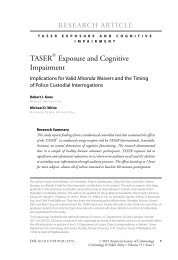1qaSADJ
1qaSADJ
1qaSADJ
Create successful ePaper yourself
Turn your PDF publications into a flip-book with our unique Google optimized e-Paper software.
Special Focus:<br />
Writing Persuasively<br />
Using the Toulmin Model of Argument in the Classroom<br />
Lawrence Scanlon<br />
Brewster High School<br />
Brewster, New York<br />
In his 1958 book, The Uses of Argument, British philosopher Stephen Toulmin presented<br />
a method for analyzing argument based on what he calls a jurisprudential model. Because<br />
this model can help bring to students a clear understanding of rhetoric and argument, we<br />
should consider its use in the classroom, since those are crucial subjects in the AP English<br />
Language and Composition course.<br />
To begin, students need to understand the words argument and rhetoric apart from<br />
their common associations. Is rhetoric the use of language to mislead or manipulate, as<br />
popular use would have it, or is it “the use of language as a symbolic means of inducing<br />
cooperation,” as Kenneth Burke says? And is argument a conflict in language, a contest<br />
between opposing verbal forces, a discussion involving disagreement, a contentious or<br />
disputatious quarrel, or is it rather a process of reasoned inquiry, of rational discourse<br />
seeking mutual ground? If the latter, then we engage in argument whenever we think<br />
clearly about the world.<br />
Students need to engage the audience, encouraging the reader to consider the positions<br />
they present as reasonable and perhaps valuable, in a voice felt as reasoned, trustworthy,<br />
and honorable, using the classic appeals to logos, pathos, and ethos. Especially important<br />
for our students to recognize is that the reasonable voice is usually a qualified one. We<br />
would probably agree that nearly all effective arguments are qualified ones. Students<br />
need not only to anticipate objections to their positions but also to recognize and<br />
respect complexity itself. A reasonable voice sees not two sides to an issue but multiple<br />
perspectives, and that voice presents an argument as the conclusion of a logical process.<br />
Students quickly discover the features of an immature argument and come to appreciate<br />
the dissuasive effect of extreme or one-sided positions and highly dyslogistic language.<br />
That “senior year is a complete waste of time” or that “Sontag’s position is stupid” is<br />
not likely to be effective with the reader. Students need to discover their own extreme<br />
positions and to question the validity of their own warrants.<br />
Types of Argument<br />
Before applying Toulmin’s method, it is good to teach students about the different types<br />
of argument. Typically, we speak of three: those of fact, of value, and of policy.<br />
AP® English Language and Composition: 2006–2007 Workshop Materials 23



